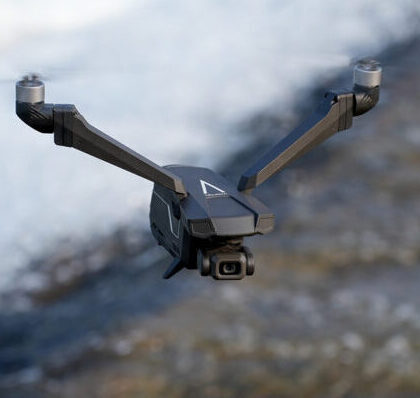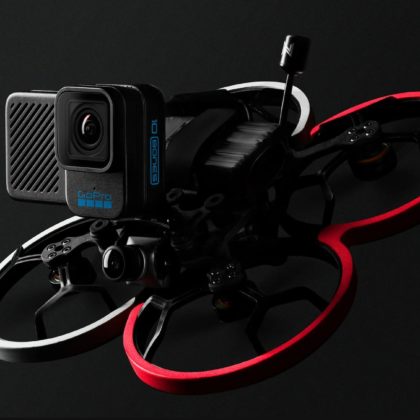The newest iPad can easily be considered as a low-cost alternative to the current generation of iPad Pro devices, but a comparison with the original iPad Pro models suggests Apple’s latest release has a lot in common with the earlier tablets. Let’s take a look at the numbers to see how close they really are.

At the original 12.9-inch iPad Pro’s launch in November 2015, it was seen as a more powerful option for those who needed to do processor-intensive work on a portable device. The introduction of the Apple Pencil helped make it into a creative powerhouse, raising its status as a premium tablet even higher.
Around four months later, the 9.7-inch iPad Pro joined the 12.9-inch version, packing the performance and Apple Pencil support into a more familiar size of device, while also adding in new features that even its larger stablemate didn’t have.
Just over two years later, Apple has brought out an iPad that includes Apple Pencil support. In that time, Apple has also shipped more powerful iterations of the iPad Pro, but the performance improvements seen in iPad over the same period could in theory have created a tablet that is better than the first iPad Pro launches.
In some respects, this is quite true, but as detailed below, it isn’t as straightforward as one would think.
Size, Screen, Heft
Starting with the obvious, the larger iPad Pro has the bigger 12.9-inch display, and an equally larger resolution than the other two at 2732 by 2048. The larger stature also translates to a heavier weight of either 1.57 pounds or 1.59 pounds depending on cellular support, over half a pound heavier than the other two.
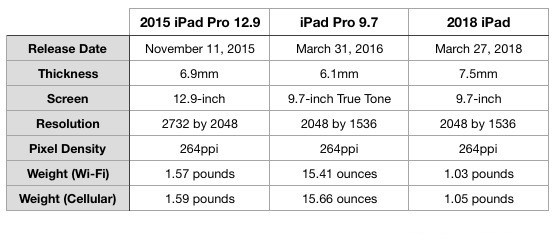
The 2018 iPad and iPad Pro 9.7 certainly have similar specifications at this point, with a 2048 by 1536-resolution 9.7-inch screen and a weight of around a pound.
The iPad Pro differs mainly from the use of a True Tone display, a system that uses a spectral-sensing ambient light sensor to measure the brightness and color of light from the local environment, with the data used to adjust the colors emitted from the display. This effectively means that the image on the True Tone display will seem to be the same to the user as they move between rooms and light sources, rather than seeming too orange or blue as can be experienced with other screens.
Apple didn’t add True Tone to the first iPad Pro, only introducing it in the 9.7-inch model, and isn’t included in the 2018 iPad either.
Performance Parity
As would be expected, the use of a faster and newer generation processor in the iPad offers better performance in benchmarks compared to the aging iPad Pro models, but it isn’t by much.
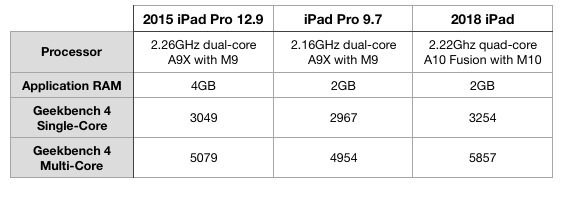
The 2018 iPad is equipped with the quad-core A10 Fusion and the M10 co-processor, clocked at 2.22GHz with 2GB of RAM. Both the iPad Pro models use a dual-core A9X with M9 co-processor, clocked at 2.26GHz and 2.16GHz for the 12.9 and 9.7-inch models respectively, with the larger-screened variant also having 4GB of memory, while the other is equipped with 2GB.
Looking at the Geekbench 4 scoring, the 2018 iPad comes out on top, achieving 3254 in single-core tests and 5857 for multi-core. The iPad Pros score 3049 and 2967 for single-core performance, making them roughly 9 percent slower, while the multi-core 5079 and 4954 scores indicate they are slower by just 15 percent.
While they were high-performance at the time of their release, the development of faster chips over time has led to the better-equipped iPad overtaking the initial iPad Pro wave in processing power. Even so, the scoring shows the old guard can give the modern rival a run for its money.
Photo and Video
The iPad Pro 12.9 and 2018 iPad have the same 8-megapixel f/2.4 rear camera, capable of recording 1080p video at 30fps. Meanwhile the iPad Pro 9.7 is equipped with a 12-megapixel f/2.2 camera capable of 4K video at 30fps and 1080p at 60fps.

While the 2018 iPad and the 12.9-inch iPad Pro can record slow-motion video at a 720p resolution at 120fps, the iPad Pro 9.7 doubles the 720p frame rate to 240fps, and can even capture 1080p video at 120fps.
Another oddity for the rear camera is the lack of flash accompanying both 8-megapixel sensors, but the 12-megapixel iPad Pro 9.7 has a dual-LED “dual tone” flash. Current iPad Pro models now use a quad LED flash, along with 12-megapixel cameras.
It is a similar story for the FaceTime camera around the front, with both the 2018 iPad and iPad Pro 12.9 capable of taking 1.2-megapixel still images and recording 720p video. Again, the iPad Pro 9.7 opts for the higher resolution 5-megapixel sensor, capable of 1080p video recording.
Connectivity
All models are capable of connecting to a wireless network using 802.11ac, and to other devices using Bluetooth 4.2. This is fairly standard for Apple’s mobile devices, as it typically takes a long time before device producers adopt newer standards, as well as for the standards themselves to be developed.

The Lightning connector continues to be the main way of physically hooking up an iPad to a Mac, as well as for charging, but again there is some slight differences. Both 9.7-inch models will communicate to a connected Mac at USB 2.0 speeds, while the iPad Pro 12.9 will do so at USB 3.0 speeds, something which could plausibly have been incorporated into the newer iPad’s design.
The iPad Pro pair also benefit from having a Smart Connector located on one side of each device, allowing it to connect to smart keyboards and other accessories, providing power and handling communications with the accessory directly. As raised in the current-generation iPad Pro comparison, the plethora of Bluetooth keyboards with long-lasting and rechargeable batteries devalues the usefulness of the connector and makes it relatively unimportant.
Miscellaneous Specifications

Another signature feature of the iPad Pro range is their use of four speakers, instead of the two used by the iPad. By having four, it means that the iPad Pro is capable of playing stereo sound correctly from each of its four display orientations. Of course, the iPad can play stereo sound as well, but using only two speakers limits proper stereo playback to just two positions.
Battery life varies considerably between models, with the iPad’s 32.4 Watt Hour battery sitting in the middle between the 38.8 Watt Hour unit in the 12.9-inch iPad Pro, and the 27.9 Watt Hour version in the 9.7-inch device. All were effectively said to provide up to 10 hours of use at launch, but two years of wear will probably cause the batteries in the iPad Pro models to provide a bit less usage time, depending on how they were treated over time.
The storage capacity options are relatively similar for all three, with the lower two capacities of 32GB and 128GB available for all models. Both iPad Pro models also offered a higher 256GB option, but while seemingly impressive, the current generation of iPad Pros boast up to 512GB of storage at their most extreme.
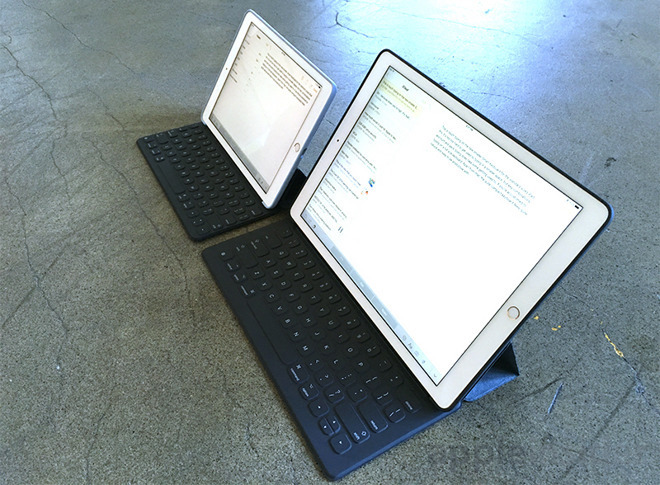
Summary: On a par…
Looking at the specifications list of each device, it is surprising how similar and how different they actually are in various ways.
Comparing the two 9.7-inch models, the iPad exceeds the performance of the old iPad Pro, and that’s to be expected. However, the better cameras, quad speakers, True Tone display, and the rear flash of the iPad Pro arguably makes up for the processing shortfall.
Moving to the 12.9-inch first-generation iPad Pro, it almost seems as though it could simply be a larger version of the new iPad. It has the same front and back cameras, pixel density, and performance in the same ballpark as the iPad.
If Apple gave the 9.7-inch iPad the same specifications as its larger stablemate, save for screen size and resolution, it could be argued that it and the new iPad would be practically the same device.
As it stands, the iPad is roughly where the iPad Pro line started over two years ago. While on the one hand this highlights Apple’s advances in the iPad product family over time, it also shows that even Apple’s older premium-level hardware is still more than usable a couple of years down the line.

